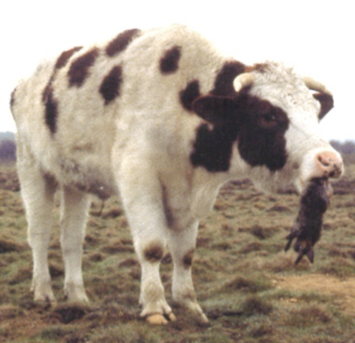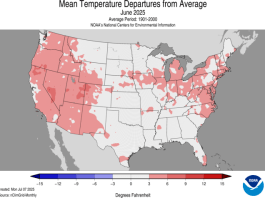

Our research has shown that animals can learn to discriminate between safe and harmful plants. Yet, why do they eat poisonous plants and die? Under most circumstances animals can learn if a plant is safe or harmful because eating any plant results in feedback from the gut to the brain. Feedback usually tells the body whether or not a food contains high levels of toxins. Unfortunately, in some situations this mechanism for discriminating safe from harmful foods is circumvented causing animals to suffer from over-ingestion of poisonous plants.
Toxins Are Everywhere
Many people assume that only poisonous plants contain toxins, but in reality toxins occur in all grasses, forbs, shrubs, and trees. Even the vegetables we grow in our gardens contain low amounts of toxins. Tomatoes and potatoes contain alkaloids, spinach contains oxalates, corn contains cyanogenic glycosides, and cabbage contains glucosinolates. Eating plants means ingesting toxins. Poisonous plants contain toxins at such high concentrations they cause obvious signs of poisoning, illness, or death.
Not All Toxins Produce Nausea
In order for animals to learn that a plant is harmful, they must experience nausea after eating the plant. Nausea causes animals to form an aversion to the plant, meaning they either stop eating or reduce intake of the plant. The alkaloids in locoweed, for example, don’t seem to cause nausea, so animals can’t learn locoweed is harmful. Of the toxins tested, most cause nausea and animals can learn to avoid them. Unfortunately, most toxins haven’t been tested (Pfister et al., 2010).
Feedback Must Occur Soon After Eating
Animals can learn to avoid eating foods provided the delay between eating and illness is 12 hours or less. Mice over-ingest d-Con because illness and death don’t occur until 4 to 5 days after eating the food. Thus, plants causing chronic toxicity problems that occur over weeks or months, such as liver disease or sloughing of the hoofs, are not likely to produce food aversions. Likewise, plants that cause birth defects may not make pregnant animals sick enough to keep them from eating the plant again (Burritt and Provenza, 1991).
No Role Model or Wrong Role Model
Livestock reared in areas with acutely toxic plants generally don’t die from eating those plants, but animals new to the area may. Young animals learn to avoid the plants their mothers avoid. When animals have no role model to teach them about acutely toxic plants, they may eat too much and die before they can learn from feedback that the plants are harmful. On the other hand, if youngsters reared by experienced mothers do eventually eat small amounts of plants their mothers avoid and get sick, they form a stronger aversion to these plants than if they experienced sickness without having mom as a model (Provenza et al., 1993). Producers in some areas with acutely toxic plants make new animals taste the plants and then stomach tube them with a sub-lethal solution of the toxic plant in water to teach them to avoid the plant.

In some cases, a toxic plant may be a novel food or livestock have been averted it. If these animals are allowed to graze with animals that readily eat the toxic plant, soon all animals will likely start eating the plant. In a research study (Figure 1), one group of cattle was trained to avoid larkspur by dosing them with lithium chloride soon after eating larkspur for the first time. Lithium chloride causes nausea and food aversions. The other group of cattle did not receive lithium chloride after eating larkspur so they readily ate larkspur. Cattle trained to avoid larkspur, did not eat it for three years. As long as cattle grazed as separate groups, those trained to avoid larkspur took no bites of larkspur, while cattle not averted larkspur took 20% (year 1), 12% (year 2) and 11% (year 3) of their bites from tall larkspur. Finally at the end of the study, the two groups of cattle were mixed and within 21 days all cattle were eating larkspur, including those trained to avoid larkspur (Ralphs and Olson, 1990).
Nutrients Send Mixed Signals

While most toxins produce food aversions, many plants high in toxins are also nutritious. Intake of a nutritious food that also contains toxins tends to be cyclical. Animals increase intake of a nutritious, toxic food until they experience illness from the toxin in the food and then they decrease intake of the food. After the animal recovers from illness it again increases intake due to the feedback from the nutrients in the food and the cycle repeats. Unfortunately, sometimes they eat too much and die. To the right is a graph of larkspur intake by a single cow over 30 days (Pfister et al., 1997).
Toxins Must Have a Distinct Flavor
Animals must be able either to taste the toxin or a flavor paired with the toxin to detect changes in toxin concentrations in foods. If the toxin concentration increases but the flavor of the plant doesn’t change then animals cannot detect the increase and they may eat too much of the plant. In some circumstances the concentration of the toxin doesn’t change but its availability increases. For example, plants that contain cyanogenic glycosides are relatively safe for ruminants to eat. The cyanide in these compounds is not released until it interacts with an enzyme in the plant as the animal chews the food or during digestion. However, after a frost, plant cell membranes rupture allowing cyanogenic glycosides and the enzyme to mix. Thus, all of the cyanide in the plant is available as soon as the animal eats the plant making it very toxic. The flavor of the plant doesn’t change but the toxicity increases (Knight and Walter, 2001).
Stress Increases Toxicity
Stress increases the potency of a toxin. For example, the alkaloids in larkspur cause an aversion but they also cause muscular paralysis and respiratory failure. If an animal eats larkspur and then is stressed by a predator or a herder, muscles don’t function properly due to the toxin in larkspur and the animal dies of respiratory failure.
New environments also cause stress. The same dose of a toxin has a much greater effect in an unfamiliar environment than a familiar one. Stress heightens the toxin’s action on the animal, likely by diminishing the effectiveness of detoxification processes, much as chronic stress suppresses immune responses. Thus, eating toxic plants in amounts that are sub-lethal in familiar settings may be deadly in unfamiliar areas (Siegel, 1976). In new environments, animals are also less likely to try new foods and aversions to foods are more likely to extinguish. Thus, if a new location contains novel foods and familiar toxic foods, animals may choose familiar toxic foods over novel foods (Burritt and Provenza, 1997).
Lack of Water or Alternative Foods

Thirsty animals often have no appetite. If high densities of poisonous plants grow near watering points, once thirsty animals drink they may over ingest poisonous plants while waiting for the rest of the herd or flock to water. Normally, if animals have a choice between eating a toxic food or starving, in most cases they’ll eat toxic plants. Animals need to have nutritious alternatives when toxic plants are present. For example in 1971, 1250 sheep from died from over-ingestion of halogen. Sheep had limited supplies of water and were hungry; as a result sheep ate 10 times the amount of halogeton to cause death (Figure 3) (EPA, 1971). Sheep can incorporate some halogeton in their diet without adverse effects, provided halogen is added to their diet slowly to let the rumen to adapt to the oxalates in halogeton and sheep eat halogeton along with other plants (James and Cronin, 1974).
Animals on a good plane of nutrition are less likely to eat poisonous plants and are better able to detoxify them if they do eat them. In addition, thin animals in poor body condition may be more likely to suffer from the effects of poisonous plants than animals in average body condition. When consuming toxic plants, animals in poor body condition have higher concentrations of toxins in their blood than animals in average body condition (Lopez-Ortiz et al., 2004).
Conclusions
Managers may be able to reduce livestock losses due to poisonous plants if they understand why animals succumb to poisonous plants. Introducing animals slowly to areas that contain poisonous plants, knowing how the toxin affects animals, providing alternative forages and ample water, and removing toxic plants near watering points will help keep animals safe.
References
Burritt, E.A., and F. D. Provenza. 1991. Ability of lambs to learn with a delay between food ingestion and consequences given meals containing novel and familiar foods. Appl. Anim. Behav. Sci. 32:179-189.
Burritt, E.A., and F.D. Provenza. 1997. Effect of a novel environment on the formation and persistence of a conditioned food aversion and ingestion of novel foods by sheep. Appl. Anim. Behav. Sci. 54:317-325.
EPA. 1971. the January 1971 Seep Death Incident Near Garrison, Utah. Radiological Research Program. US Atomic Energy Commission SF 54 373. November 1971.
James, L.F., and E.H. Cronin. 1974. Management practices to minimize death losses of sheep grazing on Halogeton-infested range. J. Range Manage. 27:424–426.
Knight A.P., and Walter R.G. 2001. A Guide to Plant Poisoning of Animals in North America. Teton New Media, Jackson, WY.
Lopez-Ortiz S, K.E. Panter, J.A. Pfister, and K.L. Launchbaugh. 2004. The effect of body condition on disposition of alkaloids from silvery lupine (Lupinus argenteus Pursh) in sheep. J. Anim. Sci. 82:2798-2805.
Pfister, J.A., F.D. Provenza, G.D. Manners, D.R. Gardner, and M.H. Ralphs. 1997. Tall Larkspur Ingestion: Can Cattle Regulate Intake Below Toxic Levels? J. Chem. Ecol. 23:759-777.
Pfister, J.A., Gardner, D.R., Cheney, C.C., Panter, K.E., Hall, J.0. 2010. The Capability of Several Toxic Plants to Condition Taste Aversions in Sheep. Small Rum. Res. 90:114-119.
Provenza, F.D., J.J. Lynch, and J.V. Nolan. 1993. The relative importance of mother and toxicosis in the selection of foods by lambs. J. Chem. Ecol. 19:313-323.
Ralphs M.H., and J.D. Olson. 1990. Adverse influence of social facilitation and learning context in training cattle to avoid eating larkspur. J. Anim. Sci. 68:1944-52.
Siegel, S. 1976. Morphine analgesic tolerance: Its situation specificity supports a Pavlovian conditioning model. Science 193:323-325.




Great article. Many many years ago I was at a forage and grasslands council conference in Montana, and someone gave a presentation that the bio feedback in sheep was a fraction of a second, that they could detect a poisonous plant while still chewing it, and spit it out. Would be a good addition to this article to see if that study can be found.
Comments are closed.